

Machine learning. Big data. Segmentation (image processing) In computer vision, image segmentation is the process of partitioning a digital image into multiple segments. The goal of segmentation is to simplify and/or change the representation of an image into something that is more meaningful and easier to analyze. Image segmentation is typically used to locate objects and boundaries in images. More precisely, image segmentation is the process of assigning a label to every pixel in an image such that pixels with the same label share certain visual characteristics. Music and Computers. Here’s a simplified view of what happens when we pluck a string: at first the string is highly energized and it vibrates like mad, creating a fairly complex (meaning rich in harmonics) sound wave whose fundamental frequency is determined by the mass and tension of the string.
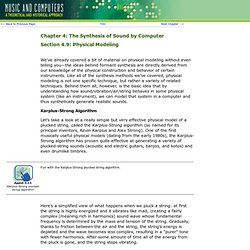
Gradually, thanks to friction between the air and the string, the string’s energy is depleted and the wave becomes less complex, resulting in a "purer" tone with fewer harmonics. After some amount of time all of the energy from the pluck is gone, and the string stops vibrating. If you have access to a stringed instrument, particularly one with some very low notes, give one of the strings a good pluck and see if you can see and hear what’s happening per the description above. A Simple and Efficient FFT Implementation in C++:<br> Part I.
Fun With Markov Chains. I am often asked about my message signature, which has been appearing at the bottom of email and Usenet postings for years now: "And Aholibamah bare Jeush, and Jaalam, and Korah: these were the borogoves...
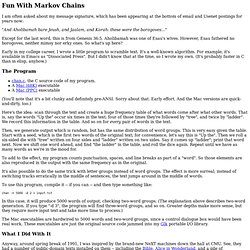
" Except for the last word, this is from Genesis 36:5. Aholibamah was one of Esau's wives. However, Esau fathered no borogoves, neither mimsy nor erky ones. So what's up here? Early in my college career, I wrote a little program to scramble text. The Program chan.c, the C source code of my program. Here's the idea: scan through the text and create a huge frequency table of what words come after what other words. Then, we generate output which is random, but has the same distribution of word groups. The Constructive Aspect of Visual Perception. A Gestalt Field Theory Principle of Visual Reification Suggests a Phase Conjugate Mirror Principle of Perceptual Computation Introduction There are many aspects of sensory and perceptual experience that exhibit a continuous spatial nature suggestive of a field theory principle of computation and/or representation in the brain.
Visual experience appears in the form of a continuous space containing perceived objects that occupy discrete volumes of that space, with spatially extended colored surfaces observed on the exposed faces of perceived objects. Augmented Reality Engineering Solutions from Metaio. Graphics & Geometric Computing Group. Research Projects.
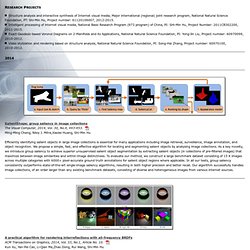
Chengfu Chen. Ke-Sen Huang organized all graphic papers on his website: Locomotion Skills for Simulated Quadrupeds Sensitive Couture for Interactive Garment Editing and Modeling Ski Stunt Simulator by Michiel van de Panne Jan 31 Locomotion in Interactive Environments. AI & Robot. David Ross - Code. Source Codes. Download source code (zip file) Authors: Mohammad Khansari Instructions: Unzip the file and read 'Readme.txt' for the instructions.
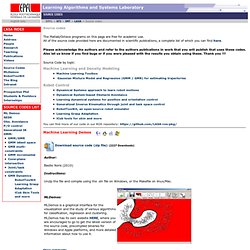
References: S.M. Obstacle avoidance is a classical problem in robotics and many approaches have been proposed to solve it. 1) it guarantees the safe collision avoidance. 2) As it only requires the differentiability of the original DS, it can be applied on a large set of DS including locally and globally asymptotically stable DS, autonomous and non-autonomous DS, limit cycles, unstable DS, etc. 3) It does not modify the critical points of the original DS. If the original DS is modeled with SEDS, the modulated DS is inherently robust to perturbations, and can instantly adapt its motion to a dynamically changing environment. Mathgen: Randomly generated math papers. Juergen Schmidhuber's home page - Universal Artificial Intelligence - New AI - Recurrent neural networks - Goedel Machine - Theory of everything - Algorithmic theory of everything - Computable universe - Zuse's thesis - Universal learning algorithms - Uni. Particle Filter Demo in Processing.
Low-rank modeling. Machine Learning. Math. MvdP Projects & Publications. Fuzzy Logic. Genetic Algorithms. Neural Networks. Machine Vision. ECCV 2010 Tutorial on Feature Learning. Organizers Kai Yu (NEC Laboratories America, kyu@sv.nec-labs.com), Andrew Ng (, ang@cs.stanford.edu) Place & Time: , , 9:00 – 13:00, September 5th, 2010 The quality of visual features is crucial for a wide range of computer vision topics, e.g., scene classification, object recognition, and object detection, which are very popular in recent computer vision venues.
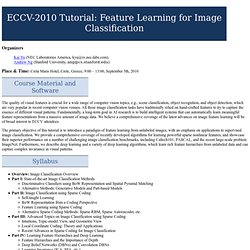
All these image classification tasks have traditionally relied on hand-crafted features to try to capture the essence of different visual patterns. The primary objective of this tutorial is to introduce a paradigm of feature learning from unlabeled images, with an emphasis on applications to supervised image classification. The slides: Software available online: Matlab toolbox for sparse coding using the feature-sign algorithm [link] Matlab codes for image classification using sparse coding on SIFT features [link] Matlab codes for a fast approximation to Local Coordinate Coding [link] Home.iitk.ac.in/~aawasthi/cs676/project/ Dekang Lin's Home Page. Source Checkout - cartwheel-3d - 3D physics-based character animation framework.